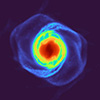 A Neptune-sized planet denser than steel has been discovered by an international team of astronomers, who believe its composition could be the result of a giant planetary clash.
A Neptune-sized planet denser than steel has been discovered by an international team of astronomers, who believe its composition could be the result of a giant planetary clash.
Sep 1st, 2023
Read more
 A new analysis of an old meteorite from the Sahara Desert suggests that a radioactive chemical known as aluminium-26, may not be as reliable for dating meteorites as previously thought because it was unevenly distributed throughout the solar system.
A new analysis of an old meteorite from the Sahara Desert suggests that a radioactive chemical known as aluminium-26, may not be as reliable for dating meteorites as previously thought because it was unevenly distributed throughout the solar system.
Aug 29th, 2023
Read more
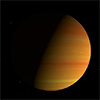 Chromium hydride, a molecule that's relatively rare and particularly sensitive to temperature, is useful as a 'thermometer for stars' because it is abundant only in a narrow range between 1,200-2,000 degrees Kelvin.
Chromium hydride, a molecule that's relatively rare and particularly sensitive to temperature, is useful as a 'thermometer for stars' because it is abundant only in a narrow range between 1,200-2,000 degrees Kelvin.
Aug 28th, 2023
Read more
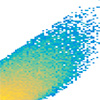 A new study sheds light on the 3D structure of nucleon resonances.
A new study sheds light on the 3D structure of nucleon resonances.
Aug 22nd, 2023
Read more
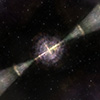 New research has improved the accuracy of the parameters governing the expansion of the Universe. More accurate parameters will help astronomers determine how the Universe grew to its current state, and how it will evolve in the future.
New research has improved the accuracy of the parameters governing the expansion of the Universe. More accurate parameters will help astronomers determine how the Universe grew to its current state, and how it will evolve in the future.
Aug 21st, 2023
Read more
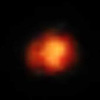 Astronomers racing to find some of the earliest galaxies ever glimpsed have now confirmed that a galaxy first detected last summer is in fact among the earliest ever found.
Astronomers racing to find some of the earliest galaxies ever glimpsed have now confirmed that a galaxy first detected last summer is in fact among the earliest ever found.
Aug 15th, 2023
Read more
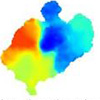 Scientists have discovered superbubble pairs generated by quasar-driven outflows of three red quasars for the first time.
Scientists have discovered superbubble pairs generated by quasar-driven outflows of three red quasars for the first time.
Aug 11th, 2023
Read more
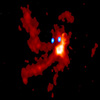 New observations and simulations of three spiral arms of gas feeding material to three protostars forming in a trinary system have clarified the formation of multi-star systems.
New observations and simulations of three spiral arms of gas feeding material to three protostars forming in a trinary system have clarified the formation of multi-star systems.
Aug 4th, 2023
Read more
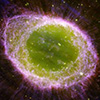 The James Webb Space Telescope (JWST) has recorded breath-taking new images of the iconic Ring Nebula, also known as Messier 57.
The James Webb Space Telescope (JWST) has recorded breath-taking new images of the iconic Ring Nebula, also known as Messier 57.
Aug 3rd, 2023
Read more
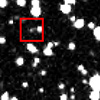 An asteroid discovery algorithm has identified its first 'potentially hazardous' asteroid, a term for space rocks in Earth's vicinity that scientists like to keep an eye on.
An asteroid discovery algorithm has identified its first 'potentially hazardous' asteroid, a term for space rocks in Earth's vicinity that scientists like to keep an eye on.
Jul 31st, 2023
Read more
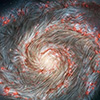 The source of magnetic fields has long been debated. New research offers clues on their origins.
The source of magnetic fields has long been debated. New research offers clues on their origins.
Jul 31st, 2023
Read more
 Researchers developed the first 3D simulations of energy rippling from a massive star's core to its outer surface. Using these new models, the researchers determined, for the first time, how much stars should innately twinkle.
Researchers developed the first 3D simulations of energy rippling from a massive star's core to its outer surface. Using these new models, the researchers determined, for the first time, how much stars should innately twinkle.
Jul 27th, 2023
Read more
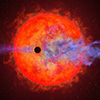 A young planet whirling around a petulant red dwarf star is changing in unpredictable ways orbit-by-orbit.
A young planet whirling around a petulant red dwarf star is changing in unpredictable ways orbit-by-orbit.
Jul 27th, 2023
Read more
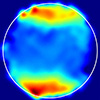 Hydrogen peroxide detected at Ganymede's poles; sulfur monoxide from Io's volcanos.
Hydrogen peroxide detected at Ganymede's poles; sulfur monoxide from Io's volcanos.
Jul 27th, 2023
Read more
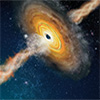 International team of scientists reports the first detection of a quasi-periodic oscillation signal in the radio band from a Galactic black hole system.
International team of scientists reports the first detection of a quasi-periodic oscillation signal in the radio band from a Galactic black hole system.
Jul 27th, 2023
Read more
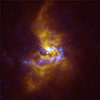 A spectacular new image released today by the European Southern Observatory gives us clues about how planets as massive as Jupiter could form.
A spectacular new image released today by the European Southern Observatory gives us clues about how planets as massive as Jupiter could form.
Jul 25th, 2023
Read more
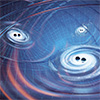 Scientists have found key evidence for the existence of nanohertz gravitational waves, marking a new era in nanohertz gravitational wave research.
Scientists have found key evidence for the existence of nanohertz gravitational waves, marking a new era in nanohertz gravitational wave research.
Jul 24th, 2023
Read more
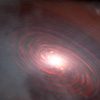 New measurements by the James Webb Space Telescope have detected water vapor at distances of less than 100 million miles from the star - the region where rocky, terrestrial planets may be forming.
New measurements by the James Webb Space Telescope have detected water vapor at distances of less than 100 million miles from the star - the region where rocky, terrestrial planets may be forming.
Jul 24th, 2023
Read more
 A Neptune-sized planet denser than steel has been discovered by an international team of astronomers, who believe its composition could be the result of a giant planetary clash.
A Neptune-sized planet denser than steel has been discovered by an international team of astronomers, who believe its composition could be the result of a giant planetary clash.
 Subscribe to our Space Exploration News feed
Subscribe to our Space Exploration News feed















